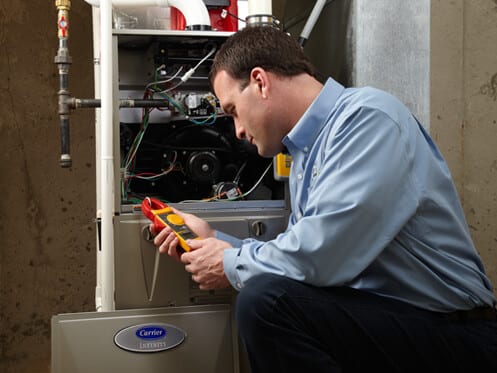
When your furnace or heat pump is experiencing problems, a simple reset may resolve the issue. However, performing the reset correctly is critical to keep you, your home, and your unit safe. Learn when you should reset your system and the procedure you need to follow to do so.
Indications You Need a Furnace Reset
Resetting a furnace typically means dealing with the reset button or resetting the control board. The first is relatively easy, while the second may take a little time.
The reset button on a furnace and heat pump is a safety feature designed to shut the system down before it trips your circuit breaker. This usually happens because of a power surge or because of your unit overheating. Once the button is triggered, the unit won’t run again after resetting the switch.
When resetting the control board, the goal is to reset the various sensors used to control the unit. Like any computer, sometimes you need to clear the signals so that the system can have a fresh start. Some indications you might need to reset your unit include:
- The system fails to start
- System is short-cycling
- The heat pump has a yellow or red light
Resetting With a Furnace Reset Button
Most furnaces have a reset button built into the system’s internal components. Regardless of what kind of system you have, you’ll want to follow the same procedures to reset this safety button. Before resetting your unit, check to ensure your air filter isn’t dirty, one of the most common causes of a reset button tripping.
To begin, lower the temperature on your thermostat as far as it will go; this will prevent it from sending a signal asking for heat. Now, turn off the power to the unit. Most modern furnaces have a light switch attached to the outside of the team or located nearby. This switch controls the electrical flow to the stove, and you want to switch it to the off position.
Once you do that, go to your breaker panel to turn off the power “upstream” from the furnace. This extra safety precaution ensures you don’t get an electrical shock.
Now, you’ll remove the front panel from the furnace, which is just removing the screws that hold it in place. You’ll know which side is the front because it’ll have the manufacturer’s label and likely the installing contractor.
Once it’s off, you’ll look for the button, which is usually red or yellow. If it needs resetting, it will have popped out. Push it back in, then follow your steps in reverse order.
Resetting Without a Reset Button
Older systems may not have a reset button, or it could be your system didn’t trip the switch. You may still want to reboot your control panel to see if that resolves your problem.
Since you already have the power turned off to your system, you’ll want to leave it off long enough that there’s no residual power in any of the components. This typically takes about 10 minutes, and you can continue getting your unit back up and running.
Considerations for a Gas Furnace
The first thing to consider with a gas furnace is whether it has a pilot light, which is ordinary in units produced before 2010. If your team has a pilot light, you must relight it during the process. If you’re uncomfortable lighting the pilot, you may want to call for a professional.
It would be best to turn the gas supply off whether you have a pilot light or an electronic ignition. To accomplish this, locate the main store coming to the furnace and turn the valve off or pilot. This will discontinue gas flowing into the unit and allow anything to dissipate before you proceed. This step is critical to prevent a furnace blowback, an uncontrolled fuel burn.
Once you go through the rest of the procedure for resetting your furnace, you must turn the gas back on. If you have a pilot light, you’ll relight that before turning on the main gas. Different furnaces have different procedures for lighting the pilot, so consult your owner’s manual for instructions for your unit.
Considerations for an Oil Furnace
If you have an oil furnace with an external fuel tank, running out of fuel may cause your reset button to trip. If this happens, you must refill the fuel tank before resetting your unit.
Once the tank is refilled, you must bleed the fuel line to prevent additional problems. There should be a bleeder valve on the pump. Put a container large enough to hold at least a quart of fuel and open the bleeder valve until a steady stream comes out without bubbles. Once you do this, you can press the reset button and work on getting the unit back up and running.
Resetting a Heat Pump
Resetting a heat pump is as easy as resetting an electric furnace. If there’s a reset button, simply pushing it should reset it. However, if you need to reset the entire system, there are a few more steps.
Start by turning the system off at the thermostat. The system has two circuit breakers, one at the condensing unit outside and one at the air handler inside. Check that both are on before switching both to the off position. Let them stay off for about 10 minutes, then turn everything back on in reverse order. Remember that your air handler will take about 60 seconds to come back on, and your condenser may take about 10 minutes to reinitialize.
When to Call a Professional
If any part of the reset process makes you uncomfortable, it’s best to leave it to a professional. Sometimes, you’ll want to call in the professionals, even if you’re comfortable doing a reset.
If your system continues tripping or needs constant resetting, it’s time to call in the professionals. The problem with constantly resetting the system is that it adds wear to your unit. Additionally, it reduces the efficiency of your system by never bringing your home’s temperature up to the desired level.
Constant resetting indicates a more in-depth issue than a random trip, such as one from a power surge. This problem could be with the limiter switch, fuel supply, circulating fan motor, burner, igniter, or a clogged exhaust vent. Instead of guessing what issue you may have, let a professional test and resolve it before it can cause further damage to your system.
People around Jacksonville have trusted McGowan's Heating & Air Conditioning to stay comfortable year-round for nearly 50 years. Our expert technicians provide heating and cooling installation, replacement, repair, maintenance, indoor air quality solutions, and duct cleaning. Call to schedule your heat pump or furnace repair appointment with one of our NATE-certified technicians today.



